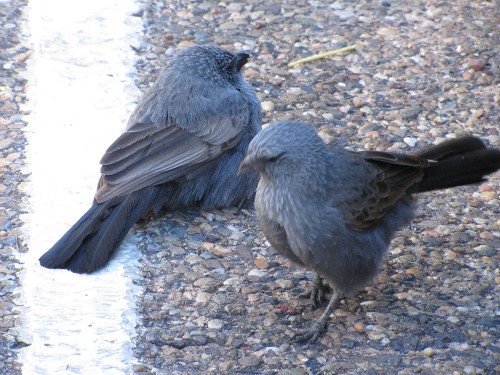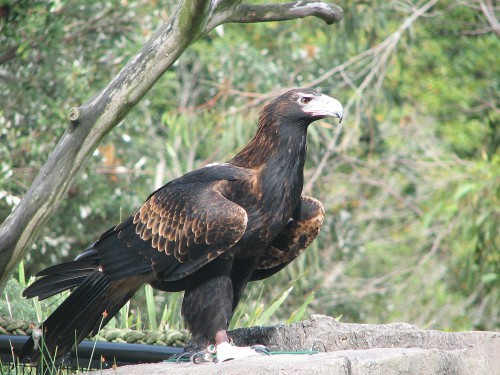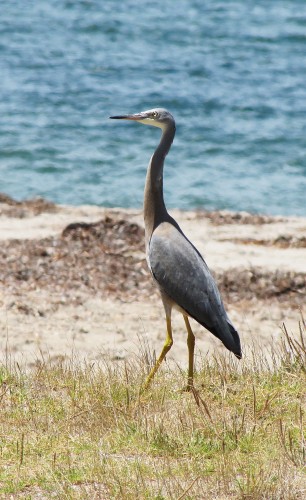Apostlebirds in Peterborough
Over the last few days we have been visiting family in Peterborough in the mid-north of South Australia. This is where my wife grew up and over the years we have visited on many occasions. This area has many of the bird species seen in the southern parts of the state but being near to the edge of the northern, drier parts of South Australia, there is a range of dry-land species as well.
The Apostlebird is not common in South Australia and I only know of a few locations where they can be reliably observed, Peterborough being one of them. Because our visit coincided with some very cold weather I didn’t venture out birding much during our three day stay, except for once when it cleared up and the sun emerged, albeit weakly. I will write about that excursion in a day or two.
As we were about to leave this morning, we lingered in the morning sun in the back garden checking out a few plants. Suddenly we observed a small flock of 6 Apostlebirds in a fruit tree just over the side fence in a neighbour’s garden. The birds just sat there preening their feathers for about five minutes before flying off again.
My sister-in-law works in the local hospital and often observes these birds in the grounds of the hospital. On one occasion recently she rang us to tell us that the Apostlebirds had visited her garden and were hopping around her as she watched.
This behaviour is consistent with my experiences elsewhere; they can be quite gregarious and quite unafraid when approaching humans, especially when food is on offer. When camping in the Hattah-Kulkyne National Park (NW Victoria) on a number of occasions years ago we experienced this species hopping onto our picnic table trying to have a share in our food. The photo above shows several birds I saw in the Western Plains Zoo car park in Dubbo, NSW, just a short distance from where several picnicking groups had been.
Our sighting in Peterborough this morning was a lovely end to a relaxing few days with family.
Further reading:
Upset birds in Artarmon
As I start this update post, I regret to say that I do not have any photos to share. The reason is simple. This article resulted from an experience I had last week while playing cricket with my six and half year old grandson. We were in his backyard here in Artarmon, north Sydney, where we are visiting at present. We were really into our game when our attention was drawn to the sound of many alarmed birds near the garden, in the street and in nearby properties. I did not have time to race inside and collect my camera.
First it was the alarm calls made by at least a dozen or more Noisy Miners. They were really upset about something but we couldn’t tell what it was. Naturally we stopped playing our game and started looking around, trying to determine the cause of their distress. My grandson, despite his youthfulness, is often aware of the birds wherever he goes. My intense interest has rubbed off on him and his father.
Next thing the local Pied Currawongs joined in the chorus, along with four or five Australian Ravens. A few seconds later three Laughing Kookaburras joined in the loud calling, along with several local Australian Magpies going stir crazy as well. The local Rainbow Lorikeets, always here in large numbers and always very noisy, set off flying in all directions, calling madly. Three Crested Pigeons skedaddled off over the roof to an unknown destination while the Noisy Miners kept up their protestations.
Meanwhile, the enormous racket unsettled both the Grey Butcherbirds and the Sulphur-crested Cockatoos, their raucous calls just adding to the general confusion. The only birds not upset were the softly twittering Welcome Swallows soaring over head. Or perhaps their twitters were in response to the noise below.
My grandson and I never discovered the reason for the commotion. We saw no evidence of a bird of prey, or an owl, or whatever had disturbed the locals. It generated quite a discussion with him about the possible causes.
We will never know. We can only speculate.
Good birding.
Tackling the big birds
Earlier this week we drove from our home in Murray Bridge to Sydney, a two day drive of over 1300km. It is a long and interesting drive. Our purpose is always to stay with our son and spend time with him and our two grandchildren.
Along the way we usually stop for morning tea, lunch and afternoon tea. I like to choose spots where I know I have a reasonable chance of seeing some birds. This does not always work; sometimes the weather conspires against good birding, like when the wind is blowing and I have trouble identifying the birds calling.
I also keep a sharp eye out as we are driving along, listing the birds I see. I should add that I only add to my list when my wife is driving, though even when I am behind the wheel I have been known to dictate lists to my wife – who obligingly scribes for me.
On this current trip I saw an interesting case of brave bird behaviour. As we neared the town of Narrandera a Wedge-tailed Eagle flew very low over our car. These are magnificent birds even when seen soaring high up in the sky, but at close quarters they are truly impressive. What made this sighting even more interesting were the two Australian magpies hotly pursuing the much larger eagle. There is obviously no love lost between these two species.
This is not an isolated or unique occurrence. I have seen smaller birds harassing much bigger species like the wedge-tail. I have even seen the comparatively small Willie Wagtail tacking a Wedge-tail Eagle. The eagle could easily swallow the wagtail in several gulps. It would be just a snack to the much larger bird.
Even more Superb Fairy-wrens
A few days ago I wrote excitedly about the increase in Superb Fairy-wrens in our garden. The numbers have risen steadily in recent years. At first we only had two, a male and a female. Later this became three, then four and soon five.
Now I have counted SIX individuals. Two days ago they all came hopping along through our garden, feeding as they came. Most of them stopped for a drink at the bird bath, and several had a quick dip. I did a quick count – and a recount to be sure. Yes – there were six of them, one in male plumage and the rest were the plain brown of the females or young males. I can never work out the different between the females and the young males.
I have observed that several of them are displaying begging behaviour, so it seems that a number of the uncoloured birds are actually recently fledged. That’s good news; it proves successful recent breeding attempts. It also bodes well for the future of this small but steadily growing population. They are quite the lovely little family group, adding much colour and character to our garden.
Further reading:
An elegant White-faced heron
Last night I was looking through some of my photos from a few years ago. I am not sure if I ever used the above photo of a White-faced heron taken at Victor Harbor on the south coast of South Australia, but it caught my eye as I scanned the photos taken on that day. (Mmmm… yes I did use it here.)
What an elegant looking bird.
Sometimes the birds we see, and photograph, almost look as if they are deliberately posing for the shot. I like that.
This also proves that even our most common birds can make wonderful subjects for our cameras.
Good birding.
Further reading:


